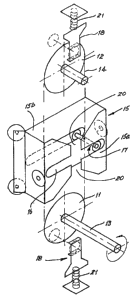Some of the information on this Web page has been provided by external sources. The Government of Canada is not responsible for the accuracy, reliability or currency of the information supplied by external sources. Users wishing to rely upon this information should consult directly with the source of the information. Content provided by external sources is not subject to official languages, privacy and accessibility requirements.
Any discrepancies in the text and image of the Claims and Abstract are due to differing posting times. Text of the Claims and Abstract are posted:
| (12) Patent: | (11) CA 1311140 |
|---|---|
| (21) Application Number: | 569431 |
| (54) English Title: | ROTARY/RECIPROCATORY MOTION CONVERTER |
| (54) French Title: | DISPOSITIF DE CONVERSION DU MOUVEMENT ROTATIF EN ALTERNATIF ET VICE VERSA |
| Status: | Deemed expired |
| (52) Canadian Patent Classification (CPC): |
|
|---|---|
| (51) International Patent Classification (IPC): |
|
| (72) Inventors : |
|
| (73) Owners : |
|
| (71) Applicants : | |
| (74) Agent: | RICHES, MCKENZIE & HERBERT LLP |
| (74) Associate agent: | |
| (45) Issued: | 1992-12-08 |
| (22) Filed Date: | 1988-06-14 |
| Availability of licence: | N/A |
| (25) Language of filing: | English |
| Patent Cooperation Treaty (PCT): | No |
|---|
| (30) Application Priority Data: | ||||||
|---|---|---|---|---|---|---|
|
ABSTRACT
This invention relates to a continuous rotary to
reciprocatory or reciprocatory to rotary motion converter
comprising a pair of wheels in spaced co-planar
relationship to each other and having an endless flexible
drive member received over them, a carrier located to both
sides of the drive member. The drive member supporting at
one location thereon a slider which extends to each side
of the drive member. The slider being slidably received
on the drive member to extend to each side thereof for
movement with the drive movement and transfers movement
relative to the axis extending between the wheels whereby
with movement of the drive member over the wheels said
carrier reciprocates between said wheels and said slider
reciprocates transversely on the carrier support means
being provided to support the slider at both sides of the
drive member from the carrier continuously throughout
movement of the carrier.
Note: Claims are shown in the official language in which they were submitted.
Note: Descriptions are shown in the official language in which they were submitted.

For a clearer understanding of the status of the application/patent presented on this page, the site Disclaimer , as well as the definitions for Patent , Administrative Status , Maintenance Fee and Payment History should be consulted.
| Title | Date |
|---|---|
| Forecasted Issue Date | 1992-12-08 |
| (22) Filed | 1988-06-14 |
| (45) Issued | 1992-12-08 |
| Deemed Expired | 2001-12-10 |
There is no abandonment history.
| Fee Type | Anniversary Year | Due Date | Amount Paid | Paid Date |
|---|---|---|---|---|
| Application Fee | $0.00 | 1988-06-14 | ||
| Registration of a document - section 124 | $0.00 | 1989-08-25 | ||
| Maintenance Fee - Patent - Old Act | 2 | 1994-12-08 | $50.00 | 1994-10-28 |
| Maintenance Fee - Patent - Old Act | 3 | 1995-12-08 | $50.00 | 1995-11-20 |
| Maintenance Fee - Patent - Old Act | 4 | 1996-12-09 | $250.00 | 1996-12-12 |
| Maintenance Fee - Patent - Old Act | 5 | 1997-12-08 | $75.00 | 1997-12-02 |
| Maintenance Fee - Patent - Old Act | 6 | 1998-12-08 | $75.00 | 1999-06-29 |
| Maintenance Fee - Patent - Old Act | 7 | 1999-12-08 | $75.00 | 1999-11-10 |
Note: Records showing the ownership history in alphabetical order.
| Current Owners on Record |
|---|
| DARTNALL ENGINEERING & INNOVATION PTY. LTD. |
| Past Owners on Record |
|---|
| DARTNALL, WILLIAM JOHN |
| LANGRIDGE, DAVID |